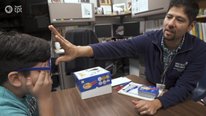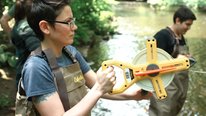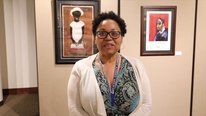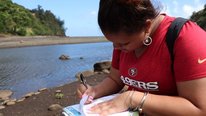- Steve Zuiker
- https://education.asu.edu/steven-zuiker
- Asst. Professor
- The School Gardener's Southwest Desert Almanac
- https://www.schoolgardenalmanac.org/
- Arizona State University ASU
- Sallie Marston
- https://geography.arizona.edu/people/sallie-marston
- Professor
- The School Gardener's Southwest Desert Almanac
- https://www.schoolgardenalmanac.org/
- University of Arizona
- Eileen Merrit
- https://education.asu.edu/eileen-merritt-0
- Asst. Professor
- The School Gardener's Southwest Desert Almanac
- https://www.schoolgardenalmanac.org/
- Arizona State University ASU
Public Discussion
Continue the discussion of this presentation on the Multiplex. Go to Multiplex









Steve Zuiker
Asst. Professor
Thanks for visiting our project and video! As a learning scientist, I'm very interested in the ways that learning opportunities consequentially link people, content. and context together. To foster deeper connections, Sallie, Eileen, and I co-organized a conference and networked learning among researchers, scientists, and teachers at school garden sites across the US southwest deserts. We're exploring how to position our common ecoregion (i.e., people and places - past, present, and future) as an anchor to support, sustain, and spread garden-based science teaching in the US southwest. Against this backdrop, below are two among many ways you might engage with our video.
Questions and connections, please!
Eileen Merrit
Lynn Baum
I think getting connected to the garden can lead to all kinds of connected questions - what insects live in the garden? How do they survive? What else is necessary for thriving plants? What does climate have to do with what grows? Once children get invested in one aspect, more questions about the interconnectedness of the natural world should follow.
Steve Zuiker
Sallie Marston
Professor
Hi Lynn, Thanks for your enthusiasm for garden-based STEM learning. We feel the same way. The interconnectedness part is highly relevant as students see themselves not only connected to nature but also to the human community that surrounds their schools.
Eileen Merrit
Asst. Professor
As a teacher educator and developmental scientist, I am interested in ways that we can support students and educators to spend more time cultivating school/ community gardens. Working with Steve, Sallie and the other educators in our ecoregion has inspired me to see how school gardens can help build and transform communities. We recognize that many educators around the world are working with students in gardens, and reflecting on practices and benefits. We would love to hear about synergistic work that you are doing!
Here are some questions that I would love to have participants respond to, in addition to the questions that Steve has raised:
1. How might we draw attention to the social and emotional benefits of gardening, for children and other participants in school and community gardens? What benefits have you noticed?
2. In what ways can native gardens help children connect to local places and organisms?
Abigail Levy
Distinguished Scholar
I'm a gardener and try to use only native plants so this project is personally so appealing to me, but it also has the potential to unlock many doors for student learning. Using a plant as a "phenomenon" of sorts, invites investigation into its structure, how it reproduces, who benefits from it, etc., as well as how it was used by humans in the past and so forth. There is so much opportunity for investigation and integration with other disciplines.
I'm curious what you've learned about how students' perceptions about the natural world around them have changed, and what that evolution looked like over time.
Eileen Merrit
Isabel Huff
Steve Zuiker
Sallie Marston
Professor
Hi Abigail, Very insightful question. I can say anecdotally, that we have observed at least two outcomes one is perceptual and the other behavioral. Perceptually, we've noticed that students who learn in gardens about biodiversity and the interdependence of soil, seed, water, sun, etc see themselves as part of that equation and they speak about how they depend on plants (and animals) and those entities depend on them. That sense of being part of the larger ecology of their campuses and neighborhoods often translates into their recognition of the interdependence of human beings, i.e. their neighbors, friends, relatives, teachers, etc.
The behavioral change we have noticed is in social and emotional development. What I mean by this is that managing the growing of plants, taking care of worms or chickens, eating food that they have grown, does affect students socially and emotionally and therefore how they operate in the world. One example is how problem-solving in real world contexts like school gardens helps to strengthen locus of control--how children from low-income, sometimes traumatized family situations believe they have agency with respect to the outcomes of events they experience. This sense of control makes them less anxious, more confident and really, more present to listen and hear and contribute to their own learning.
Marcello Rossi
Isabel Huff
Isabel Huff
This is a wonderful project! I love Arizona, so I was delighted to see it. It also reminded me of a piece by Keith H. Basso called "Wisdom Sits in Places: Notes on a Western Apache Landscape" (from 1996, a beautiful piece that brings to life ideas about place-based learning.
This is an off-the-wall suggestion, but one idea for interesting SEL connections might be to look at the benefits of caring for a living thing among the elderly. Atul Gawande, in Being Mortal, describes major changes in social and emotional health after different nursing homes brought in plants and animals.
Best wishes for your continued work!
Abigail Levy
Abigail Levy
Distinguished Scholar
Such an interesting idea, Isabel, with many possibilities. Gardening with and for our elders can be beneficial for all, and in many different ways.
Isabel Huff
Yes--and I even wondered (this is the off the wall part) if any of the literature about the ways in which caring for plants and animals positively affects the elderly might translate to similar ways in which it affects young people.
Steve Zuiker
Asst. Professor
Something else worth considering in relation to gardening with and for our elders is that it generally resonates with an earlier garden-related NSF grant to Cornell University called Garden Mosaics. Their mission statement reads: connecting youth and elders ... to investigate the mosaic of plants, people, and cultures in gardens, to learn about science, and to act together to enhance their community.
Jeffrey Ram
While we provide Professional Development in our project at our city's public aquarium and in the lagoons behind our structure, we try to encourage our teachers to try to do "biology in their backyars" and for their students "in the schoolyard." However, rather than gardens, we encourage more natural observations, not so much structuring growth as finding out what is there with it, whether an "ordinary" lawn, a wild habitat, or under the leaves that have fallen in the fall. Insects, spiders, and worms are so fascinating and educational. In the virtual PD that we will have to create this summer, we will in fact, ask teachers to do our "usual" field trip in their own backyard.
Jacqueline Genovesi
Vice President
Thank you for sharing your project. I'm wondering if/how you engage your teachers, students and families in culturally relevant learning? Do you have mechanisms for using the assets that students and families are already bringing to the project?
Sallie Marston
Professor
Hi Jacqueline, Thanks for checking out our video and for your question.
There are a few ways that you can bring these three entities together but I'll only focus on one here. In the Community and School Garden Program in Tucson, we engage teachers, students and families in culturally relevant learning by inviting family members to participate in garden-based projects. One example is designing and painting a mural of the seasonal calendar for the Tohono o'Odham tribe where the elders help to direct the mural content, the children participate in the painting and the teachers work in both the garden and the classroom to convey the 4,000 year history of agriculture in our region through the mural. In this case, the elders returned to bless the mural through burning of sage and the singing of songs of hope and good will.
Bringing family members into the school and dignifying their knowledge--whether it's expertise in stonemasonry where a stone mason grandfather teaches about the geometry of rock placement or the use of yardsticks and other measuring devices to build a wall for a tortoise habitat, or the medicinal knowledge of a family member about backyard/campus plants and their healing qualities--contributes to a truly collaborative learning experience that reflects the funds of medical and engineering knowledge that exists in a place and their often unappreciated value.
Sallie Marston
Professor
As one of the Co-PIs of the School Gardeners’ Southwest Desert Almanac Conference and a geographer and director of the University of Arizona's Community and School Garden Program, I am delighted to be part of the STEM for All Video Showcase. Out February conference was a gathering of ideas, innovation, energy and commitment that situated school gardens as dynamic teaching and learning spaces at its center. The most exciting outcome for me—besides the creation of a network of diverse and engaged school garden advocates and adherents—is the garden-based cases or lessons that are currently being assembled by participants that will be added to our website over the summer. See an exemplar here. The almanac theme of the conference is meant to recognize that science-oriented garden learning should be place-based—including recognizing the relevance of local ecology, soil, climate and weather, etc.—as well as draw from the cultural knowledge and histories of the people and the cultivation practices in that place. Our almanac will be a virtual text reflecting the collaborative production of knowledge, ideas, and practices around school garden that exist in the Southwest Desert region. It is also intended as a model for other school gardeners to develop similar almanacs that reflect the particularities of their eco-regions.
Thoughts? I'd be interested to hear from teachers, researchers and community members about the opportunities for collaborative research around school gardens they would like to see happen or have been a part of.
Alison Billman
Director of Early Elementary Curriculum
Thank you for sharing your project! Conceptualizing your network as an Almanac is an interesting idea--to me it infers an ever-evolving set of resources. In that respect, I am particularly interested in the resources that will eventually be accessible via your website and how they will support districts and teachers less familiar with gardening and animal husbandry. I have found in my work in primary schools, that teachers' interests and personal expertise are frequently the driving force for initiating school gardening programs and even on how much science teaching is happening in a classroom. What vision do you have for igniting enthusiasm for school gardens more broadly--and perhaps in eco-regions that are less easily defined (e.g. urban areas)?
Sallie Marston
Professor
Hi Alison,
Thanks for asking about how we wish to proceed. For igniting enthusiasm for school gardens we work directly with teachers through professional development opportunities that they are able to do "on the clock" by which we mean as part of their required PDs and while they are still within contract time. Setting up this relationship with the school system has really moved teachers to attend monthly workshops.
Translating the model we have developed for the Southwest is something we would like to do through national conference demonstrations as well as another conference to follow the one we recently offered where we invite school garden enthusiasts from another somewhat similar region, such as the Southeast, can help to determine what an adapted model might look like for them. As well, we have developed a network of teachers in the Southwest who are currently building curriculum that teachers anywhere can download and adapt not only for a different region but also for different grade levels. An example of this kind of lesson--on insects--could easily be altered to fit the insects that inhabit a school garden elsewhere. Here's our case for the Southwest and you can see that it would easily be applicable elsewhere.
Steve Zuiker
Asst. Professor
This question gets to the core of our grant, Alison - thank you for asking! The short answer is that we view ecoregions as common ground. This common ground makes for more readily sharing the value that garden-based science teaching creates within a school to other schools across the many districts with the same general habitat (in our ecoregion, schools in deserts with two gardening cycles every academic year). Urban areas where aspects of an ecoregion might be "muted" are tricky but the larger idea, for us, is common ground. Urban areas in the same ecoregion share more common ground. The longer answer: our vision for igniting enthusiasm, for inspiring and enabling school gardening is at least two-fold: recognizing and accelerating existing momentum.
Our efforts begin by recognizing (and being inspired by) the fact that school gardens are already growing. A resurgence in school gardening is clear from the USDA farm-to-school census. Their data provides a comprehensive, nation-wide picture of the prevalence of school gardening over time, with noteworthy growth from 2013 to 2015 alone, and a third census underway now. At the same time, this documented growth is due, in part, to numerous school garden support organizations, including city-centered networks like City Sprouts and Washington DC's School Gardens Program as well as long-standing national leadership by LifeLab. Together, the growth of gardening coupled with the good work of support organizations goes a long way in igniting enthusiasm for school gardens and, as evidence of it, there is no shortage of vision for how to accelerate these efforts, including new models like Green Our Planet.
Our own vision for accelerating school gardening seeks to involve and invest schools more deeply with both their local communities and wider ecoregion neighbors. An ecoregion is a common ground for school gardening. Teachers can use gardening to situate education activities in relation to local peoples and places- past, present, and future. Our conference created opportunities to demonstrate and discuss the practical wisdom of garden-based science teaching. We're translating these discussions into teacher-authored case studies (shaped by Halverson's (2004) idea of artifact-based phronetic narratives) to share throughout the ecoregion (we would love feedback on our case exemplar!). We're also transforming these discussions into "design conjectures." Our conjecture will enable us to explore how aspects of the demonstrations that were intentionally designed (e.g., student roles and responsibilities, resources, technology, so forth) both (1) relate to evidence-based principles about how people learn and (2) inform ongoing ecoregional co-design efforts (and new iterations of various case studies).
Marcello Rossi
Rick Heuer
Hi Steve,
As an avid gardener I find this a fascinating project. So much of science can be revealed learning where and how our food comes about. Many years ago I conducted a four year genetic experiment on my own proving Gregor Mendels theory with sorting colors of marigolds. I found it quite enlightening, always looking forward to the next year to observe the results.
My question to you, is how do you maintain a garden during the summer months when school is not in session and specifically now with the covid pandemic?
Alison Billman
Director of Early Elementary Curriculum
Thank you, Steve! Your project has reignited my interest in school gardens and I plan on sharing it with some school district leaders that I know! As we are all faced with developing flexible ways of supporting teaching and learning from a distance, do you folks have any ideas about how to keeping momentum for gardening high if students are not gathering in schools?
Eileen Merrit
Asst. Professor
Hi Allison,
Thanks for your interest! We are glad to hear that you will share our video with some school leaders. Here are a few thoughts in response to your wonderful question.
Some of our schools are harvesting food from school gardens to offer to families in the community. Manzo Elementary is a model for how to do this, and you can follow their posts on Facebook to see what they are up to!
To keep students interested, it might be a good time to have them considering what plants they might like to grow in the garden when they return. They can keep an eye out for native plants that attract pollinators to add to a butterfly garden, or research vegetables that grow well in their climate and plan a planting schedule for next year.
Providing a few seeds of a species they are unfamiliar with, and a task of drawing/measuring/writing about how they care for it and its growth pattern might also be feasible. Or perhaps challenging them to find seeds in plants near their home and see if they can grow a plant indoors with some soil they find nearby. Children are natural caretakers and collectors!
Sallie Marston
Professor
Hi Rick, Your experiment with marigolds and color is a great idea. I will be passing it along to others. We have trained Title I K-5 students to do a similar experiment where they select plants for robustness, cold and heat tolerance, resistance to insects, etc. and harvest them for continued observation the following years. These longer term experiments are a bit too long for younger grades but third graders do understand the relevance and are ready in the new school year to keep the project going.
With the marigolds, we use them to teach companion planting and their cultural relevance to community religious holidays and special events. We also use them to connect art and science where children learn to make dyes.
As to your question about garden maintenance through the summer and COVID19, I'll turn to summer first. We mostly retire our beds for the summer to save water and give the soil a rest. In those schools, however, who offer summer programs, we often maintain the gardens through a high school mentorship program we sponsor where older students support younger ones to learn from the gardens and the school's surrounding ecology. This program has been successful in social and emotional ways as well as younger kids meet older ones who look like them and come from similar communities and who are excited about gardens as learning spaces.
As for how to maintain gardens during COVID19, well, it's not dissimilar to our summer practice only that schools closed in early March at the height of the harvest season! We continued to maintain the gardens through university interns, school garden coordinators and program coordinators who are part of the UA Community and School Garden Program. We harvested over a month's worth of produce and distributed it to the low-income families in the schools we support as parents came to the schools for their children's Grab-and-Go breakfasts and lunch. Then we "zipped up" those gardens for the summer in anticipation of the monsoon rains that would irrigate--through storage in harvesting cisterns--these gardens once again come the fall.
Others have asked us how we will teach through school gardens if the K-12 students don't return in the fall because of a resurgence of COVID19. We have been actively involved in preparing for that possibility by making videos, developing more lesson plans, and creating read alongs with garden-based children's literature developed for parents and online teachers. If you are interested in seeing some of this material, please check out the following website that supports learning at a distance.
Michael I. Swart
Great hands-on work that is contextualized, relevant, necessary and inspiring. With so many levels (conservation, ecology, scientific thinking, mathematics, etc.), there are endless possibilities for a curriculum that rejuvenates every season! Thanks for sharing.
Steve Zuiker